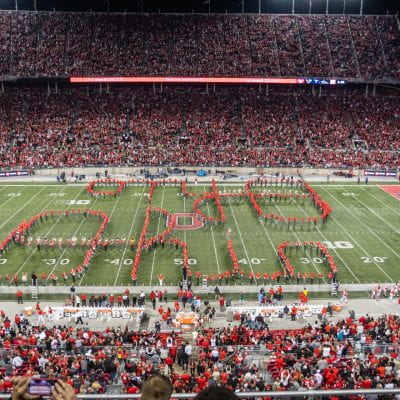
The Ohio State Marching band enters the stadium before the Ohio State-Akron game Sept. 25. Ohio State won 59-7. Credit: Christian Harsa | Special Projects Director
On Aug. 15, 2016, Katie Galuska, a sousaphone player, arrived for band night — the final stage of the marching band selection.
Sweating profusely, she entered the rehearsal hall band center. The classroom, crammed with 320 anxious student musicians dressed in their finest attire, was dead silent, Galuska said. Both veterans and newbies desperately prayed their names would be called.
Only 228 made the cut. Galuska was not one of them — and it wasn’t the first time.
“It’s a devastating experience when you spend your whole summer practicing, and not being able to hear your name read is a very, very tough experience to go through,” Galuska said. “Having gone through it twice is something that most people don’t come back for a third time to try it. But being told that your best is not good enough, it just lit a fire under me.”
Galuska, a 2019 Ohio State graduate and 2021 i-dotter for the Ohio State Marching Band, was close to never experiencing the thrill of a halftime performance, and she isn’t the only one. Although Ohio State is known for having “The Best Damn Band in the Land,” many are unaware of how much hard work and heartache is required.
Every year, 350-400 student musicians audition for the band, but only 228 make the cut, Evan Drexler, the band’s communications manager, said. Over two 12-hour days, musicians are judged by Columbus music professionals and band-elected squad leaders on their marching and playing abilities, he said.
Veteran or not, no one is guaranteed a spot, and experienced members are cut every year, Drexler said.
Upon acceptance, a musician is eligible to be in the band for five seasons, and band members are not required to be Ohio State students, Drexler said. Every year, about 10-15 members have full-time jobs or attend other universities in the area. In 2015, he said there was a 50-year-old band member.
“We have a ton of students who get cut that first time or two times and come back and make it their second or third try,” Drexler said. “When you’re coming back and you really want to be in this band, you’re working hard for it. You know what’s expected of you and you can practice for things more specifically.”
During the audition process, there are two rounds of cuts. Ryan Harris, a fifth-year in computer science & engineering and snare drummer in the band, said he was eliminated during the first round of his 2017 audition.
“It was pretty devastating, but I honestly wouldn’t change it,” Harris said. “We all kind of hit this point where we think we’re as good as we’re going to be. It’s nice to understand that you are capable of doing something so much better. Just be patient and take the time to build yourself up to that.”
Even after making the band, musicians aren’t always guaranteed a spot on the field, Harris said. Every Monday, two alternates challenge a regular player for their spot, which is how Harris, who made the band as a 2018 alternate, said he secured his position.
“It felt amazing. It felt like a big relief that I finally achieved the goal that I set out to do many years ago,” Harris said. “I was finally able to march in ‘The Best Damn Band in the Land’ with my brother again, who’s in the band as well.”
Although the road was difficult, Galuska said she wouldn’t change her experience for the world.
“It was worth the heartache and the journey that it took to get here,” Galuska said. “I wouldn’t give up any single hour of practice or any tear that I had the years that I got cut because honestly it led me to this, and I’m having the best time of my life right now.”





